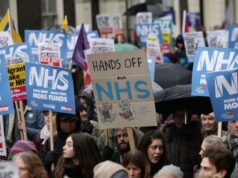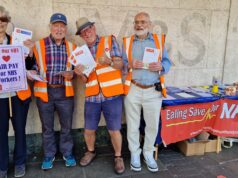Issue: 30
November 2015
This occasional newsletter is researched, written and edited by a group of concerned residents in Ealing, West London who want to preserve our NHS. We view the wholesale engagement of private, for-profit healthcare service suppliers as unnecessary, profligate and dangerous. Process improvement is what is needed in our NHS – not revolution.
Is the NHS NW London ‘Shaping a Healthier Future’ Programme/Strategy Being ‘Disappeared’?
The ‘Shaping a Healthier Future’ (SaHF) programme proposed in 2012 ‘…changes that will improve care both in hospitals and the community and will save many lives each year’. However the real goal was to cut spending by £1billion by 2015.
The SaHF web site at www.healthiernorthwestlondon.nhs.uk has been revamped and any ‘banner’ reference to ‘Shaping a Healthier Future’ has been removed! The last SaHF reference is a 28 August 2015 news item ‘Shaping a healthier future – information for your area’. When you click on ‘…download your area Fact Pack here’ – nothing happens. No fact pack, no information – no SaHF any more perhaps?
What could this mean? Here are a few choices:
- SaHF is now complete and is at its scheduled end. However this is clearly not the case
- SaHF is being abandoned, possibly because the bloated £1.3 billion capital funding cannot be secured
- SaHF is being abandoned because the perennially delayed 20+ business cases needing to be finalised will not stand up to public scrutiny.
First Mental Health Recovery House Opened in Ealing
On 9 October 2015 the West London Mental Health Trust (WLMHT) opened its first Recovery House in Ealing. Amadeus House in Corfton Road has 17 private bedrooms and 24/7 residential community-based care. It provides an alternative to hospital care and offers a half-way house between discharge from hospital and a return home. The home is being run by the charity Rethink Mental Illness. As well as bedrooms there is a beautiful garden, ‘quiet rooms’ for residents and a communal kitchen and lounge.
This recovery facility was originally to be located at the Lammas Centre on Mattock Lane. Although empty in recent years the centre has been owned and used by the NHS for over 60 years. Plans were drawn up to convert the building. The Council agreed these plans. Then, all of a sudden, the NHS/WLMHT sold the building for private development for £2.9 million.
Incidence of Tuberculosis (TB) is Still High in Ealing
The London Assembly has published World Health Organisation figures which show that parts of London still have high rates of TB. The worst borough is Newham with 107 cases out of 100,000 residents. Ealing is fourth worst with 62 cases, but parts of Ealing had rates of over 150. The UK average rate was 13. The rate in Iraq was 45.
Are Hunt, Osborne and Cameron Making Conscious Efforts to Antagonise All NHS Staff?
It is impossible to run a viable, sustainable universal healthcare service when huge swathes of NHS staff are disenchanted with current or future proposed conditions of work.
Prime Minister Cameron’s obsession with seven day working is clearly driving junior doctors and GPs out of their jobs and future careers in England. With regard to seven day working of GP surgeries, some of the pilot schemes indicate very low demand by patients for surgeries on Sundays. Also if you have a finite number (or reducing number) of GPs trying to ‘spread’ service across seven days rather than five, this must degrade the service during week days.
Junior doctors say that the new terms and conditions now being offered specify a 90 hour week and will result in between 15% and 40% loss of earnings. They think the Government proposals are dangerous for patients, doctors and the health service. The BMA is balloting junior doctors as from 5 November 2015 about taking industrial action. Over 50,000 medics will have two weeks during which to cast their vote. Thousands of junior doctors demonstrated outside Parliament on 28 September 2015 and on 17 October 20,000 marched in London to support the junior doctors! On that day 1,000s demonstrated in Nottingham and 100s in Belfast. Hundreds demonstrated in Leeds town centre on 28 September and on 28 October. Around 1,000 demonstrated in the centre of Manchester on 29 September. On 24 October 4,000 junior doctors and their supporters marched through Newcastle centre. Other packed meetings of junior doctors were held in September and October in Liverpool, Newmarket, Southampton and Durham. Meetings in November are scheduled in Birmingham, Taunton and Oxford. Secretary of State Jeremy Hunt MP’s response to these demos is that junior doctors don’t understand the good deal they are being offered. His stance is both patronising and pathetic.
As for nurses, those from non-EU countries will be deported, if after six years in this country, they are not earning more than £35,000 per year. The Royal College of Nursing calculates that 6,620 non-EU nurses will have to be deported by 2020. The Government temporarily eased the situation last month by lifting the ban on recruiting nurses from overseas. A Unison survey earlier this year revealed that 55% of hospital nurses are caring for eight or more patients on night shifts.
The Unison survey also revealed that a third of ambulance service paramedics have taken time off for stress.
Chancellor Osborne wants to reduce tax credits. This will cut the wages of low paid workers, who will no doubt include hospital ancillary workers such as porters and cleaners and GP surgery receptionists. Some families will lose more than £3,000 per year. Heartening and inspiring pleading in the House of Lords on 26 October gave Osborne a bloody nose on the Tax Credits Bill and stopped the Bill becoming an Act of Parliament on that day. Baroness Hollis performed like a saint and Tory Earl Howe attempted bullying tactics, but was publicly humiliated.
According to Roy Lilley (nhsManagers.net) there are currently 33 Chief Executive posts vacant in the NHS.
In October 2015, The Guardian’s ‘ClockOff’ survey revealed that of all public sector workers those working in the NHS are the most stressed. 61 % reported they are stressed all or most of their time at work. 26% don’t take any break during the working day. 96% work beyond their contracted hours – on average working five extra hours per week.
So the Government has managed to stress out and upset NHS bosses, doctors, nurses, paramedics and ancillary workers. Is this any way to run our national health service?
‘For Emergency use only: A&E is for life-threatening emergencies only’
NHS posters with this headline are appearing. The 195 bus (Southall to Brentford) is displaying one. Just what are these posters all about?
If I hurt my leg (possibly fracturing it), because it’s not a ‘life-threatening’ condition should I not go to a hospital A&E unit?
If I’m in pain and clearly ill, am I supposed to diagnose myself as to whether I am close to death and suitable to be treated at a hospital A&E unit?
As most hospital A&E units seem to have Urgent Care Centres (UCCs) co-located with them surely people who have been involved in accidents and are in pain should not be discouraged from going to hospital?
Just where are those people hurt in accidents supposed to go if not to hospital?
NHS Better Care Fund (BCF): Probably Frozen in 2016: Possibly Redundant in 2017
NHS England has announced its intention to freeze the BCF National Government contribution in 2016/17 at £3.8 billion. The BCF is an attempt to integrate NHS healthcare and Local Authority social care. The BCF was announced in June 2013 and the grand hope was that it would be spent in such a way as to reduce emergency admissions to hospitals. The fund amalgamated some existing NHS funds (£3.8 billion) and Local Authority funds (almost £2 billion) to create an initial annual budget of £5.3 billion. The dream was that the BCF would lead to savings of £1 billion each year.
In November 2014 the National Audit Office (NAO) branded the BCF a shambles. The NAO could not find any evidence as to exactly how these cash and A&E savings could be achieved. In February 2015, the Public Accounts Committee (PAC) concluded that the initial intention of the BCF – to transform local health and social care services by pooling resources – had been replaced by the intention to protect NHS resources. The PAC echoed serious concerns by Local Authorities that BCF was failing to protect adult social care services.
The NHS England BCF web site stopped publishing ‘user’ comments and questions in April 2015 and the last NHS reply to one of them was in February 2015. The latest FAQ information was published in August 2014.
It now seems the world has moved on and that BCF will be quietly buried as a failure. Regional devolution, capitalised budgets allocated directly to providers and integrated personal commissioning are, according to ‘Health Services Journal’, the bolder solutions which will make BCF redundant.
TTIP and ISDS Still Pose Major Threats to Keeping Our NHS Public
TTIP is the Transatlantic Trade and Investment Partnership. Its supposed purpose is to make it easier and cheaper for EU companies to sell to US customers and vice versa. Proponents talk about cutting down on red tape, simplifying regulatory processes and increasing international trading revenues. Critics say that TTIP will lead to the adoption of lower environmental, health and safety standards. Even the most optimistic financial projections for TTIP reveal very small increases in transatlantic trading sales and profits.
ISDS stands for Investor State Dispute Settlement. It gives foreign investors and foreign trading companies the right to sue nation states in private arbitration courts for any action which could damage their profit expectations. ISDS emerged in Germany in 1959 when the first Bilateral Investment Treaty (BIT) was signed with Pakistan. Its history however goes back much further and its existence is a response to the inadequacy of international law in protecting the property of foreigners. International arbitration has been used to resolve claims by foreign investors since the 18th century. ISDS is embedded in 3,400 investment agreements worldwide. The UK has 94 BITs almost all of which include ISDS provisions.
TTIP/ISDS negotiations between EU and US officials have been taking place behind closed doors for months and months. Opposition to TTIP/ISDS is particularly strong in Austria and Germany. For the EU to ratify any TTIP/ISDS agreement all EU nation states will have to sign up to it. Proposed ISDS provisions in TTIP have a 20 year timescale and would be binding even if the UK exited the EU.
The concern for the NHS is that US healthcare giants will use TTIP/ISDS to sue the UK government if they feel they are being excluded from bidding for NHS contracts or when they lose such contracts.
20 UK Councils have voted to reject TTIP. In London only one Council has done this – Lewisham.
On 7 October 2015 a European Citizens’ anti-TTIP petition was presented to the European Commission in London. With 3,263,920 signatories it was the largest petition of its kind.
On 26 October 2015 ‘The Independent’ announced that leaders of Labour, UKIP, SNP and Green parties had all signed a public appeal for the NHS to be excluded from any TTIP/ISDS agreement. Prime Minister Cameron refused to sign.




